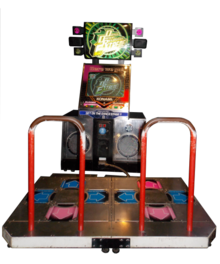Dance Dance Revolution (DDR) is a music video game series produced by Konami. Introduced in Japan in 1998 as part of the Bemani series, and released in North America and Europe in 1999, Dance Dance Revolution is the pioneering series of the rhythm and dance genre in video games. Players stand on a "dance platform" or stage and hit colored arrows laid out in a cross with their feet to musical and visual cues. Players are judged by how well they time their dance to the patterns presented to them and are allowed to choose more music to play to if they receive a passing score.
Dancing Stage is a series of music video games developed and published by Konami. It is a spin-off of Dance Dance Revolution for the European market as well as a few Japanese titles. Games were released for arcade, PlayStation, PlayStation 2 and Wii.

Pop'n Music, commonly abbreviated as Pop'n, PM or PNM and stylized as pop'n music, is a music video game series in the Bemani series made by Konami. The games are known for their bright colors, upbeat songs, and cute cartoon character graphics. Originally released in 1998, the series has had 22 home releases in Japan as well as 30 mainline arcade versions.
DDRMAX Dance Dance Revolution 6thMix is the 6th game in the Dance Dance Revolution series of music video games. It was released in the arcades by Konami on October 19, 2001, and for the PlayStation 2 on May 16, 2002, in Japan. 6thMix contains a total of 42 songs, all which made their first arcade appearance on this release. 11 of these songs debuted in various console releases prior to 6thMix. All arcade songs from Dance Dance Revolution to Dance Dance Revolution 5thMix were removed in 6thMix, although many of the Konami originals from those games would later be revived in future arcade releases.
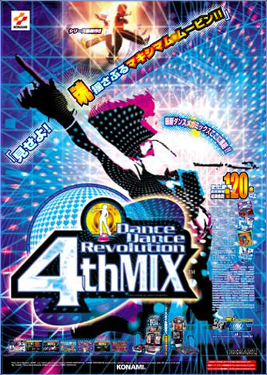
Dance Dance Revolution 4thMix is the fourth game in the main Dance Dance Revolution series of music video games. It was released as an arcade game by Konami on August 24, 2000 in Japan. 4thMix features 136 songs, of which 37 are new songs available and 12 are new unlockables that require an operator code. Dance Dance Revolution 4thMix Plus is an update that unlocks these 12 songs without an operator code, while also adding 14 new songs of its own, for a total of 150 songs.
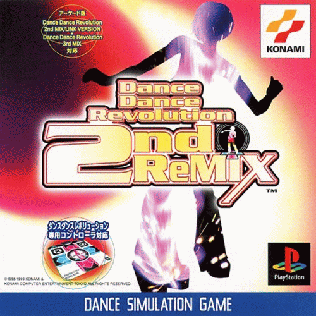
Dance Dance Revolution 2ndMix, sometimes abbreviated as 2ndMix, is the second game in the Dance Dance Revolution series of music video games. It was released as an arcade game by Konami on January 29, 1999. The initial release has a total of 33 songs: 22 brand new songs, and 11 from its predecessor, Dance Dance Revolution.
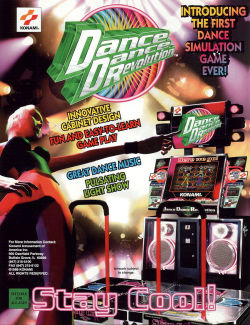
Dance Dance Revolution (DDR) is a music video game, developed by Konami, released in arcades on September 26, 1998, in Japan. Dance Dance Revolution is a unique game involving dance and rhythm that defined the genre. It involves timing and balance by having players use their feet instead of their hands like typical video games. In March 1999, the game was released for North American arcades, and for European arcades under the name Dancing Stage. Players and game critics were caught off-guard by the game's addictive qualities winning the new franchise many merits to its design.

Dance Dance Revolution SuperNova, released in Europe as Dancing Stage SuperNova, is an arcade and PlayStation 2 game in the Dance Dance Revolution (DDR) series of music video games. It was produced by Konami and released through Betson Enterprises. The game was released in Europe on April 28, 2006, followed shortly by a North American release on May 15 and a Japanese release on July 12.
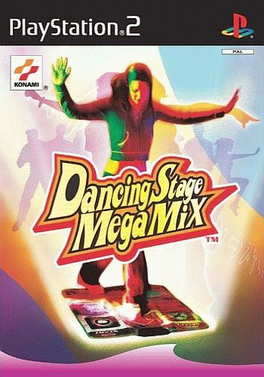
Dancing Stage MegaMiX is the fifth home release in the Dancing Stage series, a European version of the Dance Dance Revolution series of music video games. MegaMix was the first Dancing Stage game released on the Sony PlayStation 2 game console - and as with Dancing Stage EuroMix 2, MegaMix introduced many new features to Europe, such as Freeze Arrows, the Options menu, and a cleaner interface. Based largely on Dancing Stage EuroMix 2, MegaMiX was separated from the arcade game by a completely different track list of songs. The game was marketed by Konami as a family game and an exercise tool in efforts to make the niche series more mainstream.
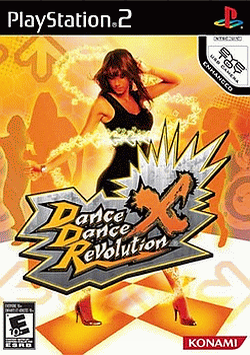
Dance Dance Revolution X is a music video game developed by Konami. A part of the Dance Dance Revolution series, it was announced in 2008 for Japan and on May 15, 2008, for the North American PlayStation 2. The arcade version was announced on July 7, 2008, July 9, 2008 in Europe, and July 10, 2008, for North America. Released to celebrate the 10th anniversary of Dance Dance Revolution, DDR X sports an improved interface, new music, and new modes of play. The arcade release featured an overhauled cabinet design with a widescreen display, e-Amusement and USB access, and an improved sound system. Despite such new design of its arcade cabinet, upgrade kit to change the edition of DDR on its first generation arcade cabinet from SuperNOVA2 to X is also available. The PlayStation 2 release has link ability with the arcade machine, multi-player support over LAN, and other improved and returning features such as EyeToy support. DDR X was called a "truly global version", with a multi-regional release by all three major Konami houses.
The music of Dance Dance Revolution X is a collection of tracks that are playable on Dance Dance Revolution X, a music video game first released in Japan by Konami on December 24, 2008, then later in Europe on June 3, 2009 and North America on June 9, 2009. The soundtracks for the different releases are primarily dance, hip hop, and synthpop based with additional tracks covering multiple other genres.

Dance Dance Revolution, released in Europe as Dance Dance Revolution Hottest Party 4 for the Wii version and Dance Dance Revolution New Moves for other versions, is a music video game in the Dance Dance Revolution series, with this entry developed by Konami's American division. Unveiled at E3 2010, it was released for the Wii and PlayStation 3 in North America on November 16, 2010. A port of this version for the Xbox 360 was also released on April 12, 2011. It is also the only game in the series to be released for the PlayStation 3, as well as the final game in the series to be released for the Xbox 360.
Dance Dance Revolution Extreme has a robust soundtrack. It includes many licensed tracks as well as in-house original music that was written and performed by Konami staff.

Dance Dance Revolution X2 is a music video game, and a part of the Dance Dance Revolution series. The arcade version of DDR X2 was revealed by Konami on November 20, 2009. The sequel to Dance Dance Revolution X, X2 began public beta testing on November 25, 2009. The game was released in Japan and Asia on July 7, 2010, North America on December 31, 2010, and Europe on May 13, 2011. It was the last arcade installment of Dance Dance Revolution with international releases until Dance Dance Revolution A.

Dance Dance Revolution X3 is a music video game, and a part of the Dance Dance Revolution series. The arcade version of DDR X3 was revealed by Konami on June 2, 2011. The sequel to Dance Dance Revolution X2, X3 began public beta testing on June 8, 2011. Promotional information for the game revealed the full name for the game, called Dance Dance Revolution X3 VS 2ndMix due to the new "2ndMix" mode in the game. It was released in Japan on November 16, 2011 for dedicated cabinets and November 30, 2011 for upgrade kits, and December 16, 2011 in Asia.

Dance Dance Revolution II, later released in Europe as Dance Dance Revolution Hottest Party 5, is a music video game in the Dance Dance Revolution series by Konami. It was released on October 11, 2011 for the Nintendo Wii in North America and on November 24, 2011 in Europe. Dance Dance Revolution II is the direct sequel to Dance Dance Revolution for the Wii. This game shares songs with the arcade version of Dance Dance Revolution X3 vs 2ndMix. It features characters from the arcade versions of Dance Dance Revolution. It was the final DDR game release for the Nintendo Wii and is the latest in the series to be released for a home console as of 2023.
Dance Dance Revolution (DDR) is a music video game, the 14th installment of the Dance Dance Revolution series, and the sequel to Dance Dance Revolution X3 vs. 2ndMix. The game was revealed by Konami on October 24, 2012. Public beta testing commenced on October 26, 2012. It was released in Japan on March 14 and 21, 2013 for dedicated cabinets and upgrade kits, respectively, and in Asia on March 21, 2013. A limited test release occurred at select locations in the United States, beginning on August 4, 2015.

Dance Dance Revolution A is a music video game, the 16th installment of the Dance Dance Revolution arcade series in Japan, and the sequel to the 2014 release of Dance Dance Revolution. It was released on March 30, 2016 in Japan and Asia as a dedicated cabinet and as an upgrade kit, with Japan receiving a localized build, while the Korean release was delayed to the next week. This game was also released in North America later in 2016, in the form of new cabinets with e-Amusement connectivity, while Europe received new offline cabinets on December 15, 2017. It is the first international arcade release of Dance Dance Revolution since Dance Dance Revolution X2.

Dance Dance Revolution A20 is a music video game, the 17th installment of the Dance Dance Revolution arcade series in Japan, and the sequel to Dance Dance Revolution A. The game was released on new, golden cabinets on March 20, 2019, in Japan. A software upgrade for older cabinets for Japan and Asia was released on July 24, 2019, with South Korea receiving a localized release on August 1, 2019, and North America on September 24, 2019. A location test in Europe began on October 7, 2019, and ended on March 16, 2020.

